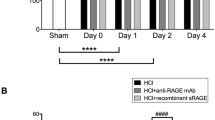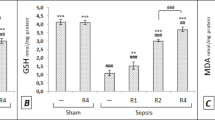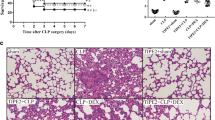Abstract
Lidocaine (Lido) is reported to suppress inflammatory responses and exhibit a therapeutic effect in models of cecal ligation and puncture (CLP)-induced acute lung injury (ALI). The receptor for advanced glycation end product (RAGE) exerts pro-inflammatory effects by enhancing pro-inflammatory cytokine production. However, the precise mechanism by which Lido confers protection against ALI is not clear. ALI was induced in RAGE WT and RAGE knockout (KO) rats using cecal ligation and puncture (CLP) operations for 24 h. The results showed that Lido significantly inhibited CLP-induced lung inflammation and histopathological lung injury. Furthermore, Lido significantly reduced CLP-induced upregulation of HMGB1 and RAGE expression and activation of the NF-κB and MAPK signaling pathways. With the use of RAGE KO rats, we demonstrate here that RAGE deficiency attenuates the protective effect of Lido against CLP-induced lung inflammatory cell infiltration and histopathological lung injury. These results suggest that RAGE deficiency attenuates the protective effect of Lido against CLP-induced ALI by attenuating the pro-inflammatory cytokines production.









Similar content being viewed by others
REFERENCES
Schouten, L.R., M.J. Schultz, A.H. van Kaam, N.P. Juffermans, A.P. Bos, and R.M. Wosten-van Asperen. 2015. Association between maturation and aging and pulmonary responses in animal models of lung injury: a systematic review. Anesthesiology 123: 389–408.
Villar, J., D. Sulemanji, and R.M. Kacmarek. 2014. The acute respiratory distress syndrome: incidence and mortality, has it changed? Current Opinion in Critical Care 20: 3–9.
Takao, Y., K. Mikawa, K. Nishina, N. Maekawa, and H. Obara. 1996. Lidocaine attenuates hyperoxic lung injury in rabbits. Acta Anaesthesiologica Scandinavica 40: 318–25.
Feng, G., S. Liu, G.L. Wang, and G.J. Liu. 2008. Lidocaine attenuates lipopolysaccharide-induced acute lung injury through inhibiting NF-kappaB activation. Pharmacology 81: 32–40.
Howlett, T., and J. Lerman. 2006. Effects of lidocaine and steroids on breast milk-induced lung injury in rabbits. Paediatric Anaesthesia 16: 523–9.
Lee, P.Y., P.S. Tsai, Y.H. Huang, and C.J. Huang. 2008. Inhibition of toll-like receptor-4, nuclear factor-kappaB and mitogen-activated protein kinase by lignocaine may involve voltage-sensitive sodium channels. Clinical and Experimental Pharmacology and Physiology 35: 1052–8.
Cohen Jr., M.M. 2013. Perspectives on RAGE signaling and its role in cardiovascular disease. American Journal of Medical Genetics Part A 161A: 2750–5.
Uspenskaya, Y.A., Y.K. Komleva, E.A. Pozhilenkova, V.V. Salmin, O.L. Lopatina, A.A. Fursov, P.V. Lavrentiev, O.A. Belova and A.B. Salmina. 2015. [Ligands of RAGE-Proteins: Role in Intercellular Communication and Pathogenesis of Inflammation]. Vestnik Rossiĭskoĭ Akademii Meditsinskikh Nauk 6: 694–703.
Lutterloh, E.C., and S.M. Opal. 2007. Antibodies against RAGE in sepsis and inflammation: implications for therapy. Expert Opinion on Pharmacotherapy 8: 1193–6.
Reynolds, P.R., R.E. Schmitt, S.D. Kasteler, A. Sturrock, K. Sanders, A. Bierhaus, P.P. Nawroth, R. Paine 3rd, and J.R. Hoidal. 2010. Receptors for advanced glycation end-products targeting protect against hyperoxia-induced lung injury in mice. American Journal of Respiratory Cell and Molecular Biology 42: 545–51.
Wood, T.T., D.R. Winden, D.R. Marlor, A.J. Wright, C.M. Jones, M. Chavarria, G.D. Rogers, and P.R. Reynolds. 2014. Acute secondhand smoke-induced pulmonary inflammation is diminished in RAGE knockout mice. American Journal of Physiology - Lung Cellular and Molecular Physiology 307: L758–64.
Ramsgaard, L., J.M. Englert, M.L. Manni, P.S. Milutinovic, J. Gefter, J. Tobolewski, L. Crum, G.M. Coudriet, J. Piganelli, R. Zamora, Y. Vodovotz, J.J. Enghild, and T.D. Oury. 2011. Lack of the receptor for advanced glycation end-products attenuates E. coli pneumonia in mice. PloS One 6: e20132.
Wang, H.L., W.H. Zhang, W.F. Lei, C.Q. Zhou, and T. Ye. 2011. The inhibitory effect of lidocaine on the release of high mobility group box 1 in lipopolysaccharide-stimulated macrophages. Anesthesia and Analgesia 112: 839–44.
Wang, H.L., Y.Q. Xing, Y.X. Xu, F. Rong, W.F. Lei, and W.H. Zhang. 2013. The protective effect of lidocaine on septic rats via the inhibition of high mobility group box 1 expression and NF-kappaB activation. Mediators of Inflammation 2013: 570370.
van Zoelen, M.A., H. Yang, S. Florquin, J.C. Meijers, S. Akira, B. Arnold, P.P. Nawroth, A. Bierhaus, K.J. Tracey, and T. van der Poll. 2009. Role of toll-like receptors 2 and 4, and the receptor for advanced glycation end products in high-mobility group box 1-induced inflammation in vivo. Shock 31: 280–4.
Deng, Y., Z. Yang, Y. Gao, H. Xu, B. Zheng, M. Jiang, J. Xu, Z. He, and X. Wang. 2013. Toll-like receptor 4 mediates acute lung injury induced by high mobility group box-1. PloS One 8: e64375.
Yu, M., D. Shao, J. Liu, J. Zhu, Z. Zhang, and J. Xu. 2007. Effects of ketamine on levels of cytokines, NF-kappaB and TLRs in rat intestine during CLP-induced sepsis. International Immunopharmacology 7: 1076–82.
Liu, J., H. Zhang, Z. Qi, and X. Zheng. 2014. Lidocaine protects against renal and hepatic dysfunction in septic rats via downregulation of Tolllike receptor 4. Molecular Medicine Reports 9: 118–24.
Li, K., J. Yang, and X. Han. 2016. Ketamine attenuates sepsis-induced acute lung injury via regulation of HMGB1-RAGE pathways. International Immunopharmacology 34: 114–28.
Lutterloh, E.C., S.M. Opal, D.D. Pittman, J.C. Keith Jr., X.Y. Tan, B.M. Clancy, H. Palmer, K. Milarski, Y. Sun, J.E. Palardy, N.A. Parejo, and N. Kessimian. 2007. Inhibition of the RAGE products increases survival in experimental models of severe sepsis and systemic infection. Critical Care 11: R122.
Lee, W., O.K. Kwon, M.S. Han, Y.M. Lee, S.W. Kim, K.M. Kim, T. Lee, S. Lee, and J.S. Bae. 2015. Role of moesin in HMGB1-stimulated severe inflammatory responses. Thrombosis and Haemostasis 114: 350–63.
Yuan, T., Z. Li, X. Li, G. Yu, N. Wang, and X. Yang. 2014. Lidocaine attenuates lipopolysaccharide-induced inflammatory responses in microglia. The Journal of Surgical Research 192: 150–62.
Tobon-Velasco, J.C., E. Cuevas, and M.A. Torres-Ramos. 2014. Receptor for AGEs (RAGE) as mediator of NF-kB pathway activation in neuroinflammation and oxidative stress. CNS Neurol Disord Drug Targets 13: 1615–26.
Author’s Contributions
ZZ, JZ, CL, XL, ML, DS, and XJ conceptualize, design, analyze, and interpret the data and wrote the manuscript.
Author information
Authors and Affiliations
Corresponding author
Ethics declarations
Conflicts of Interest
The authors report no proprietary or commercial interest in any product mentioned, or concept discussed, in this article.
Rights and permissions
About this article
Cite this article
Zhang, Z., Zhou, J., Liao, C. et al. RAGE deficiency attenuates the protective effect of Lidocaine against sepsis-induced acute lung injury. Inflammation 40, 601–611 (2017). https://doi.org/10.1007/s10753-016-0507-z
Published:
Issue Date:
DOI: https://doi.org/10.1007/s10753-016-0507-z




